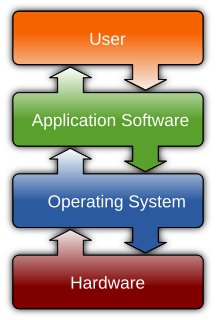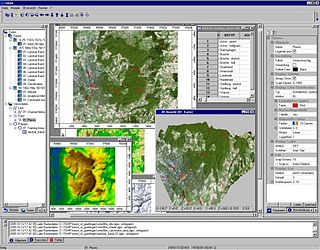This article contains weasel words: vague phrasing that often accompanies biased or unverifiable information.(March 2014) |

JUICE is a widely used[ citation needed ] non-commercial software package for editing and analysing phytosociological data.

Computer software, or simply software, is a collection of data or computer instructions that tell the computer how to work. This is in contrast to physical hardware, from which the system is built and actually performs the work. In computer science and software engineering, computer software is all information processed by computer systems, programs and data. Computer software includes computer programs, libraries and related non-executable data, such as online documentation or digital media. Computer hardware and software require each other and neither can be realistically used on its own.
Phytosociology is the branch of science which deals with plant communities, their composition and development, and the relationships between the species within them. A phytosociological system is a system for classifying these communities.
Contents
It was developed at the Masaryk University in Brno, Czech Republic in 1998, and is fully described in English manual. It makes use of the previously-developed TURBOVEG software for entering and storing such data) and it offers a quite powerful tool for vegetation data analysis, including:

The Czech Republic, also known by its short-form name, Czechia, is a landlocked country in Central Europe bordered by Germany to the west, Austria to the south, Slovakia to the east and Poland to the northeast. The Czech Republic covers an area of 78,866 square kilometres (30,450 sq mi) with a mostly temperate continental climate and oceanic climate. It is a unitary parliamentary republic, with 10.6 million inhabitants; its capital and largest city is Prague, with 1.3 million residents. Other major cities are Brno, Ostrava, Olomouc and Pilsen. The Czech Republic is a member of the European Union (EU), NATO, the OECD, the United Nations, the OSCE, and the Council of Europe.
- creation of synoptic tables
- determination of diagnostic species according to their fidelity
- calculation of Ellenberg indicator values for relevés, various indices of alpha and beta diversity
- classification of relevés using TWINSPAN or cluster analysis
- expert system for vegetation classification based on COCKTAIL method etc.
Indicator value is a term that has been used in ecology for two different indices. The older usage of the term refers to Ellenberg's indicator values, which are based on a simple ordinal classification of plants according to the position of their realized ecological niche along an environmental gradient. More recently, the term has also been used to refer to Dufrêne & Legendre's indicator value, which is a quantitative index that measures the statistical alliance of a species to any one of the classes in a classification of sites.
In ecology, alpha diversity (α-diversity) is the mean species diversity in sites or habitats at a local scale. The term was introduced by R. H. Whittaker together with the terms beta diversity (β-diversity) and gamma diversity (γ-diversity). Whittaker's idea was that the total species diversity in a landscape is determined by two different things, the mean species diversity in sites or habitats at a more local scale and the differentiation among those habitats.
In ecology, beta diversity is the ratio between regional and local species diversity. The term was introduced by R. H. Whittaker together with the terms alpha diversity (α-diversity) and gamma diversity (γ-diversity). The idea was that the total species diversity in a landscape (γ) is determined by two different things, the mean species diversity at the habitat level (α) and the differentiation among habitats (β). Other formulations for beta diversity include "absolute species turnover", "Whittaker's species turnover" and "proportional species turnover".



